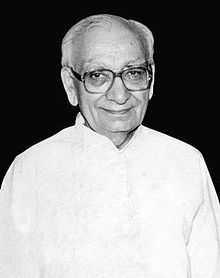Krishan Kant
| Krishan Kant | |
|---|---|
 | |
| Vice President of India | |
| In office 21 August 1997 – 27 July 2002 | |
| President | Kocheril Raman Narayanan |
| Preceded by | Kocheril Raman Narayanan |
| Succeeded by | Bhairon Singh Shekhawat |
| Governor of Tamil Nadu | |
| In office 22 December 1996 – 25 January 1997 | |
| Chief Minister | Muthuvel Karunanidhi |
| Preceded by | Marri Chenna Reddy |
| Succeeded by | Fatima Beevi |
| Governor of Andhra Pradesh | |
| In office 7 February 1990 – 21 August 1997 | |
| Chief Minister | Marri Chenna Reddy Nedurumalli Janardhana Reddy Kotla Vijaya Bhaskara Reddy Nandamuri Taraka Rama Rao Nara Chandrababu Naidu |
| Preceded by | Kumudben Manishankar Joshi |
| Succeeded by | G. Ramanujam |
| Personal details | |
| Born | 28 February 1927 |
| Died | 27 July 2002 (aged 75) |
| Political party | Janata Dal (1988–2002) |
| Other political affiliations |
Indian National Congress (Before 1977) Janata Party (1977–1988) |
| Spouse(s) | Shrimati Suman |
| Alma mater | Indian Institute of Technology (BHU) Varanasi[1] |
| Profession | Scientist |
| Religion | Hinduism |
| Signature |  |
Krishan Kant (28 February 1927 – 27 July 2002) was the tenth Vice President of India from 1997 until his death.
Kant's first brush with politics came when he plunged into the Quit India movement, while he was still a student in Lahore. He took part in the Indian Independence Movement as a youth and continued to be involved in politics, eventually being elected to Parliament of India. He was part of the "Young Turk" brigade of Indian National Congress party during the time of Indira Gandhi. He held prominent offices in the Parliamentary and Organisational wings of Indian National Congress and later the Janata Party and the Janata Dal.[2] He was a member of the Executive Council, for several years, of the Institute for Defence Studies and Analyses.
Krishan Kant was the founding general secretary of the People's Union for Civil Liberties and Democratic Rights, of which Jayprakash Narayan was the President in 1976. He was expelled from the Indian National Congress in 1975 for his opposition to the Emergency. He was later a member of Lok Sabha till 1980.[2] He was the chairman of Committee on Railway Reservations and Bookings from 1972 -1976.
He with Madhu Limaye was also responsible for the collapse of the Morarji Desai government installed by that coalition, by insisting that no member of the Janata Party could be the member of Rashtriya Swayamsevak Sangh (RSS). This attack on dual membership was directed specifically at members of the Janata Party who had been members of the Jan Sangh, and continued to be members of the right-wing RSS, the Jan Sangh's ideological parent. The issue led to fall of Morarji Desai government in 1979, and the destruction of the Janata coalition[3]
A strong protagonist of India going nuclear, Krishan Kant was a member of the executive council of the Institute of Defence Studies and Analysis.[2]
Kant was appointed governor of Andhra Pradesh by the V.P. Singh government in 1989 and served in that position for seven years, becoming one of India's longest-serving governors. He stayed at that post till he was elevated as Vice-President of India.
He was elected vice-president by Parliament as the joint candidate of the Indian National Congress and United Front. He died in New Delhi. He is the only Indian Vice President to die in office.
References
- ↑ ${FireSpark.core.helper.readControl($value)}. "Training & Placement Cell, IIT (BHU) Varanasi". Iitbhu.ac.in. Retrieved 2013-02-22.
- ↑ 2.0 2.1 2.2 "Rajya Sabha". Rajya Sabha. Retrieved 2013-02-22.
- ↑ "In Pursuit of Lakshmi: The Political Economy of the Indian State", By Lloyd I. Rudolph and Susanne H. Rudolph, University of Chicago Press, 1987. pp 457-459.
External links
- Profile on Embassy of India in Washington website
| Political offices | ||
|---|---|---|
| Preceded by Kumudben Manishankar Joshi |
Governor of Andhra Pradesh 1990–1997 |
Succeeded by G. Ramanujam |
| Preceded by Marri Chenna Reddy |
Governor of Tamil Nadu 1996–1997 |
Succeeded by Fatima Beevi |
| Preceded by Kocheril Raman Narayanan |
Vice President of India 1997–2002 |
Succeeded by Bhairon Singh Shekhawat |